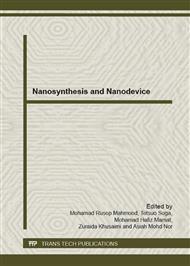[1]
S. Iijima, Nature 354 (1991) 56-58.
Google Scholar
[2]
M. Dresselhaus, G. Dresselhaus, P.C. Eklund, Science of Fullerenes and Carbon Nanotubes, Academic Press, San Diego, USA, (1996).
DOI: 10.1002/adma.19970091518
Google Scholar
[3]
M. B. Nardelli, B. I. Yakobson and J. Bernholc, Phys. Rev. B 57 (1998) 4277.
Google Scholar
[4]
C.M. Lieber, Top. Appl. Phys. 80 (2001) 173.
Google Scholar
[5]
C. Journet, W.K. Maser, P. Bernier, A. Loiseau, M.L. de la Chapelle, S. Lefrant, Nature 388 (1998) 756.
Google Scholar
[6]
T. Guo, P. Nikoleav, A. Thess, D.T. Colbert, R.E. Smalley, Chem. Phys. Lett. 243 (1995) 49.
Google Scholar
[7]
Siang-Piao Chai, Sharif Hussein Sharif Zein and Abdul Rahman Mohamed, Chem Phys Lett 426 (2006) 345-350.
Google Scholar
[8]
S. Amelinckx, X.B. Zhang, D. Bernaerts, X.F. Zhang, V. Joanov, J.B. Nagy, Science 265 (1994) 635.
Google Scholar
[9]
A. Cassell, N. Franklin, E. Chan, J. Han, H. Dai, J. Am, Chem. Soc. 121 (1999) 7959.
Google Scholar
[10]
R. Kamalakaran, M. Terrones, T. Seeger, Ph. Kohler-Redlich, M. Ruhle, Y.A. Kim, T. Hayashi, M. Endo, Appl. Phys. Lett. 77 (2000) 3385.
DOI: 10.1063/1.1327611
Google Scholar
[11]
K. Mukhopadhyay, K.M. Krishna, M. Sharon, Phys. Rev. Lett. 72 (1994) 3184.
Google Scholar
[12]
K. Mukhopadhyay, M. Sharon, Mater. Chem. Phys. 49 (1997) 105.
Google Scholar
[13]
K. Mukhopadhyay, K.M. Krishna, M. Sharon, Mater. Chem. Phys. 49 (1997) 252.
Google Scholar
[14]
M. Sharon, K. Mukhopadhyay, K. Yase, S. Iijima, Y. Ando,X. Zhao, Carbon 56, 284 (1998).
Google Scholar
[15]
J. Guo and A.C. Lua, Mater. Lett. 55 (2002) 334.
Google Scholar
[16]
Aik Chong Lua and Jia Guo, Carbon 36 (11) (1998) 1663-1670.
Google Scholar
[17]
M. Sharon, K. Mukhopadhyay, I. Mukhopadhyay, K.M. Krishna, Carbon 33 (1995) 331.
Google Scholar
[18]
M. Sharon, K. Mukhopadhyay, K. Yase, S. Iijima, Y. Ando, X. Zhao, Carbon 36 (1998) 507.
DOI: 10.1016/s0008-6223(98)00060-8
Google Scholar
[19]
M. Sharon, N. Sundarakoteeswaran, P.D. Kichambare, M. Kumar, Y. Ando, X. Zhao, Diam. Relat. Mater. 8 (1999) 485.
Google Scholar
[20]
K. Mukhopadhyay, I. Mukhopadhyay, M. Sharon, T. Soga, M. Umeno, Carbon 35 (1997) 863.
DOI: 10.1016/s0008-6223(97)80177-7
Google Scholar
[21]
K.M. Krishna, T. Soga, K. Mukhopadhyay, M. Sharon, M. Umeno, Sol. Energy Mater. Sol. Cells 48 (1997) 25.
Google Scholar
[22]
M. Sharon, M. Kumar, P.D. Kichambare, N.R. Avery, K.J. Black, Mol. Cryst. Liquid Cryst. 340 (2000) 523.
Google Scholar
[23]
M. Kumar, P.D. Kichambare, M. Sharon, N.R. Avery, K.J. Black, Mater. Chem. Phys. 66 (2000) 83.
Google Scholar
[24]
Rakesh A. Afre, T. Soga, T. Jimbo, Mukul Kumar, Y. Ando, M. Sharon, Prakash R. Somani, M. Umeno, Microporous and Mesoporous Materials (2006) 184-190.
DOI: 10.1016/j.micromeso.2006.06.036
Google Scholar


